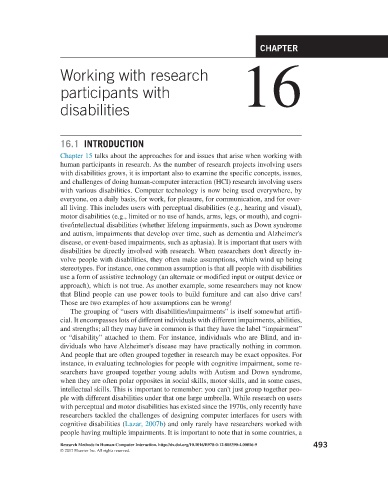Page 500 -
P. 500
CHAPTER
Working with research 16
participants with
disabilities
16.1 INTRODUCTION
Chapter 15 talks about the approaches for and issues that arise when working with
human participants in research. As the number of research projects involving users
with disabilities grows, it is important also to examine the specific concepts, issues,
and challenges of doing human-computer interaction (HCI) research involving users
with various disabilities. Computer technology is now being used everywhere, by
everyone, on a daily basis, for work, for pleasure, for communication, and for over-
all living. This includes users with perceptual disabilities (e.g., hearing and visual),
motor disabilities (e.g., limited or no use of hands, arms, legs, or mouth), and cogni-
tive/intellectual disabilities (whether lifelong impairments, such as Down syndrome
and autism, impairments that develop over time, such as dementia and Alzheimer's
disease, or event-based impairments, such as aphasia). It is important that users with
disabilities be directly involved with research. When researchers don't directly in-
volve people with disabilities, they often make assumptions, which wind up being
stereotypes. For instance, one common assumption is that all people with disabilities
use a form of assistive technology (an alternate or modified input or output device or
approach), which is not true. As another example, some researchers may not know
that Blind people can use power tools to build furniture and can also drive cars!
Those are two examples of how assumptions can be wrong!
The grouping of “users with disabilities/impairments” is itself somewhat artifi-
cial. It encompasses lots of different individuals with different impairments, abilities,
and strengths; all they may have in common is that they have the label “impairment”
or “disability” attached to them. For instance, individuals who are Blind, and in-
dividuals who have Alzheimer's disease may have practically nothing in common.
And people that are often grouped together in research may be exact opposites. For
instance, in evaluating technologies for people with cognitive impairment, some re-
searchers have grouped together young adults with Autism and Down syndrome,
when they are often polar opposites in social skills, motor skills, and in some cases,
intellectual skills. This is important to remember: you can't just group together peo-
ple with different disabilities under that one large umbrella. While research on users
with perceptual and motor disabilities has existed since the 1970s, only recently have
researchers tackled the challenges of designing computer interfaces for users with
cognitive disabilities (Lazar, 2007b) and only rarely have researchers worked with
people having multiple impairments. It is important to note that in some countries, a
Research Methods in Human-Computer Interaction. http://dx.doi.org/10.1016/B978-0-12-805390-4.00016-9 493
© 2017 Elsevier Inc. All rights reserved.

